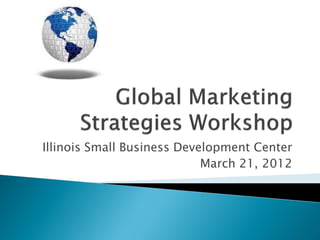Global Marketing Strategies Workshop
•
1 gefällt mir•393 views
I presented this for the Illinois Small Business Development Center at College of Lake County on April 12, 2012. The audience was comprised of businesses extending to overseas markets.
Melden
Teilen
Melden
Teilen
Downloaden Sie, um offline zu lesen

Empfohlen
I presented to the International Roundtable of the University of Chicago\'s Graduate School of Business on April 12, 2012Cross-Cultural Change Management: The Merger of East and West Germany

Cross-Cultural Change Management: The Merger of East and West GermanyRuth-Ann (Ruth Ann) McKellin, MBA
Empfohlen
I presented to the International Roundtable of the University of Chicago\'s Graduate School of Business on April 12, 2012Cross-Cultural Change Management: The Merger of East and West Germany

Cross-Cultural Change Management: The Merger of East and West GermanyRuth-Ann (Ruth Ann) McKellin, MBA
Weitere ähnliche Inhalte
Empfohlen
Empfohlen (20)
Product Design Trends in 2024 | Teenage Engineerings

Product Design Trends in 2024 | Teenage Engineerings
How Race, Age and Gender Shape Attitudes Towards Mental Health

How Race, Age and Gender Shape Attitudes Towards Mental Health
AI Trends in Creative Operations 2024 by Artwork Flow.pdf

AI Trends in Creative Operations 2024 by Artwork Flow.pdf
Content Methodology: A Best Practices Report (Webinar)

Content Methodology: A Best Practices Report (Webinar)
How to Prepare For a Successful Job Search for 2024

How to Prepare For a Successful Job Search for 2024
Social Media Marketing Trends 2024 // The Global Indie Insights

Social Media Marketing Trends 2024 // The Global Indie Insights
Trends In Paid Search: Navigating The Digital Landscape In 2024

Trends In Paid Search: Navigating The Digital Landscape In 2024
5 Public speaking tips from TED - Visualized summary

5 Public speaking tips from TED - Visualized summary
Google's Just Not That Into You: Understanding Core Updates & Search Intent

Google's Just Not That Into You: Understanding Core Updates & Search Intent
The six step guide to practical project management

The six step guide to practical project management
Beginners Guide to TikTok for Search - Rachel Pearson - We are Tilt __ Bright...

Beginners Guide to TikTok for Search - Rachel Pearson - We are Tilt __ Bright...
Global Marketing Strategies Workshop
- 1. Illinois Small Business Development Center March 21, 2012
- 2. How to best promote products overseas How to better understand international customers How to find and use correct sales channels How to use the best brand promotion vehicles How to do global networking How to use best practices in international sales How to adapt sales message by understanding cultural differences
- 3. “Know Thyself” – and your product
- 4. 1. Identify your target market and market size a. Continent i. Consider risk and opportunity b. Country i. Gather information from country Chambers of Commerce ii. Attend events sponsored by Chambers of Commerce; some will be general, some by industry c. Areas within country/Regions i. Regions often have business development offices ii. Take into consideration proximity to customers (Lean Thinking)
- 5. 2. Consider a “pilot” (e.g. IKEA) 3. Determine support sources (Federal, State, City). Sometimes export tours are offered. 4. Inform yourself about legalities of bringing your product into the global market. Tariffs? Other stumbling blocks? 5. Other sources of information a. Determine what U.S. competitors are doing b. Research competitors in target markets (national companies) c. Industry associations/connections
- 6. 1. Learn culture as related to your products a. Readiness/openness to new things i. Where will your product be accepted? (e.g. Michigan Asparagus Growers) ii. Perception of American products in your industry (e.g. flooring) iii. Open or closed market
- 7. 2. Learn the culture of business a. How do they sell within their markets? What are the risks of adapting? (e.g. same price country- wide drives customer service—washing machines, SAP, etc.)
- 8. b. What are the legal differences? Employment law? (e.g. “Hire and Fire” is a very American concept.) How does the U.S. law compare to other countries’ business practices? c. Resources i. business schools (especially those with specialties in International Business, e.g. Michigan State); ii. language institutions--such as the Goethe Institut--sometimes have specific courses about business culture iii. find business people from that market who aren’t in your industry iv. “reverse engineering” – what difficulties did a company from your target market have when entering the US culture, regardless of industry?
- 9. d. Look at values—do the business values mesh with yours? Consider countries with similar values (e.g. Canada) 3. Learn the culture of the country a. Resources i. meet people from your target countries ii. Libraries iii. Universities or schools – places where they teach the culture of your target countries.
- 10. Evaluate how you want to enter the global market. Different levels of risk are associated with each option: 1. Purchase an entity in a foreign market 2. Partner with a company in the foreign market 3. Export your product and use distributors 4. Evaluate assembly there 5. Manufacture in the target company, either using your own facility or having manufacturing done through someone else (distributed by…)
- 11. 1. Check your brand name in other languages! 2. Explore whether there are novel channels we don’t have or use here 3. Determine if an advertising agency can give you the best insight for your initial approach a. Mass market What will reach the masses in that market? b. Business to business (B2B) i. Relationships and introductions – can “buy” them by hiring nationals who have established relationships for business development and proven track records. ii. Talk to end customers about what service levels they require. The voice of the customer (VOC) is essential.
- 12. c. Specialized market Trade shows, demonstrations, recommendations Trade shows will probably give you the most “hands-on” information for the least money. Look at international industry shows—who from your target market is attending? (e.g. Widget International Show) Are there shows at the national level in your target markets? (e.g. Widget Show of New Zealand) Identify related industry leaders and talk to them
